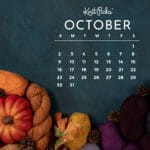For our 20th Anniversary, we revisited some of our 20 most popular patterns, and Abbye Meiklejohn helped rewrite and add sizes to a selection of our older garment patterns. She joins hosts Lee and Stacey to tell them about her process for rewriting existing patterns and expanding their size range while maintaining the original look and feel. Abbye also shares how she likes to approach grading patterns for a larger size and the difference between extending pattern sizes and the individual knitter customizing their sweater.
Our hosts also reveal some fears around steeking and pattern photoshoot sample disasters, and Abbye shares a few stories of her own, including singeing a pattern sample while steaming!
Mentioned in this Episode
Andi’s Swedish magazine cover inspiration
Grafting with Kitchener Stitch
Timestamps
- 00:03 Welcome to the Knit Picks Podcast
- 00:21 Lee and Stacey have their knitting motivation back!
- 04:50 We’re having an office KAL with everyone knitting Eldfell
- 13:00 We revisited older patterns for the anniversary
- 15:42 Abbye Meiklejohn tells the podcast about the anniversary pattern she worked on.
- 18:02 Abbye made the biggest changes on Chromatic and shares why.
- 20:25 Abbye’s experience reworking other designers’ patterns.
- 25:02 Adding sizes and Abbye’s advice for designers who are extending their size range.
- 27:57 Changing ease trends and individual ease preferences.
- 30:30 Abbye’s favorite patterns to work on from our anniversary patterns
- 31:35 Our hosts reveal their steeking fears and other confessions
- 38:19 What Abbye is working on next and where to find her work with Wool and Pine.
- 41:23 Credits




